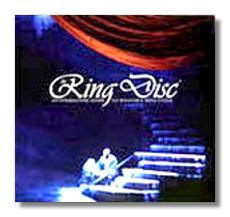
The Internet's Premier Classical Music Source
Related Links
- Latest Reviews
- More Reviews
-
By Composer
-
Collections
DVD & Blu-ray
Books
Concert Reviews
Articles/Interviews
Software
Audio
Search Amazon
Recommended Links
Site News
 CD-ROM Review
CD-ROM Review
The Ring Disc

An Interactive Guide to Wagner's Ring Cycle
The Media Café Publishing
An amazing CD-ROM. Imagine, if you will, a single CD that gives you the entire Ring des Nibelüngen in Solti's classic Decca performance with the Vienna Philharmonic, as well as plot synopsis, piano-vocal score, German libretto with English translation, a list of Leitmotivs, character explications, and so on. I have no idea how they did this. The price lists at $99.99 (US). It requires at least:
- A Pentium PC running Windows 95 or Windows NT
- 8 MB RAM
- 4x CD-ROM drive
- 16-bit color with 800x600 screen resolution
- 16-bit sound card and speakers
The PC investment isn't cheap, but if you have this minimum configuration already, you might look into this CD.
One way that the authors of this software could give you so much was to give you less than top-notch sound. This is not a substitute for commercial CDs of the Ring. Solti's version consists of fifteen discs, just to give you some idea of the loss of sound quality. On the other hand, my computer speakers and sound card can't reproduce CD sound as well as my CD player, pre-amp, amplifier, subwoofer, and speakers, so there's really no need for that level of sonic grandeur. We have here a "study guide," not a performance.
The number of different audiences, at different levels of musical sophistication, addressed by the CD impresses me the most. You can be a duffer, someone familiar with the cycle, a music reader or non-reader, and the guide will give you help. I would think the best way to start would be with the music itself. While it plays, you can view the German-English libretto, with a running description of the music in words which points out salient features as they occur. If you happen to read music, and you click on a hyperlink to a motiv to see the notes that comprise the motiv. You can also follow along with the piano-vocal score. About the only musical aspect of the Ring the CD does not address fully is the orchestration, although the running commentary does give you highlights.
The glory and the problem of the Ring is its huge cast of characters and its even larger number of musical cells, or leading motives (Leitmotiven). Wagner begins with little musical bits and builds mighty scena. Wagner wrote to Liszt a letter expressing his amazement (he was probably his own biggest fan) that his entire opera grew out of an E Flat Major triad. You can just about watch this unfold through the guide in Das Rheingold's Prélude and opening scene, as one Leitmotiv after another bubbles out of the increasingly complex counterpoint. However, Wagner's method of composition in the Ring is to take these bits and recombine them and vary them throughout the opera, in such a way that they almost always comment dramatically upon the action. How he kept it all straight is almost unfathomable, since apparently he never explicitly charted these things. Even the Ring enthusiast can learn something by tracing the development and new contexts of these motives throughout all four operas. The Leitmotiv list allows you to do so easily. In fact, it's fairly easy to navigate through the entire program. The instruction booklet is slim and sufficiently helpful.
The commentary is clearly written, if not world-beatingly penetrating in its insight, but real books are probably the best way to get deeper into the cycle. This CD will give you a very solid foundation to continue your acquaintance with this mind-boggling monument of Romanticism.
I should also mention, however, the great musicologist Deryck Cooke's "An Introduction to Der Ring des Nibelungen," available on two London CDs (443 582-2). Decca originally released these as a "companion" to Solti's cycle. It has 193 musical examples, a complete list of the motives used, and Cooke's brilliant organizing mind which takes you through the cycle practically motive by motive, without losing his (or your) bearings. He also constructs elegant mini-arguments about several issues in the Ring. This may still be available from BMG Record Club.
In all, the CD-ROM is a noteworthy achievement, and I recommend it to novices and old operatic hands alike.
Copyright © 1997, Steve Schwartz












